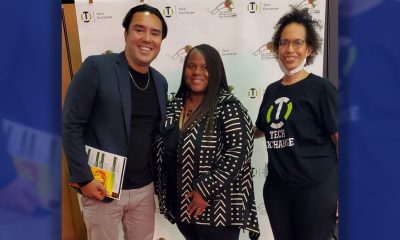Technology
Don’t Sound the Death Knell for the PC Just Yet

The ATIV One 7 Curved computer is on display at the Samsung booth during the International CES, Tuesday, Jan. 6, 2015, in Las Vegas. (AP Photo/John Locher)
BRANDON BAILEY, AP Technology Writer
LAS VEGAS (AP) — A year ago, pundits were declaring the personal computer dead. Smartphones and tablets were cannibalizing sales, and the once-revolutionary PC seemed unnecessary — and boring.
Sure, a smartphone is great for checking emails, snapping photos and playing games. Tablets are perfect for watching videos and shopping online. But don’t count the PC out just yet. Manufacturers are crafting high-resolution, curved screens for desktops and other new features you can’t get in a hand-held device, while trying new laptop designs that mimic the tablet’s appeal.
“For the last couple of years, mobile devices have been the hot commodity,” acknowledges Dell executive Neil Hand. “But we’re seeing a re-emergence of innovation in the PC space.”
For years, PC innovation consisted mostly of putting faster processors or a bigger hard-drive inside the same basic box. That didn’t really matter when the personal computer was a mostly unchallenged commodity. Global PC shipments peaked at more than 365 million units in 2011. But then sales fell off dramatically as tablets stole hearts and wallets. PC sales plunged 10 percent in 2013 alone, according to research firm Gartner Inc., marking the worst annual decline in the industry’s history. They slipped a little further last year, to about 314 million units. PC makers say they understand the need to evolve, and at the annual gadget show International CES in Las Vegas this week are showing off many new features aimed at wooing back consumers.
Depth-sensing cameras, for example, are popping up in high-end desktops and laptops. Intel vice president Navin Shenoy said his company’s “RealSense” camera can recognize its owner’s face and unlock a PC without requiring a typed password. Intel is also promoting software that uses the camera in games that respond to a player’s head or hand movements.
PC makers are borrowing ideas from tablets, with laptops that are increasingly thin and lightweight, with longer battery life. Dell’s new XPS 13 notebook has a screen that extends nearly to the edge of the frame, like the screen on many tablets. By eliminating wider borders, Dell says it can fit a larger screen into a smaller frame.
Several companies have hybrid or convertible devices that resemble a tablet with a physical keyboard attached. Lenovo, the Chinese company that has become the world’s biggest seller of PCs, is rolling out several new models of its Yoga hybrid, first introduced last year, with a keyboard that fully folds back so you can hold the display like a tablet.
Lenovo CEO Yang Yuanqing told The Associated Press in an interview that the new “convertible” hybrids will eventually replace the laptop computer for most people, because they are lighter and have longer battery life. “Now it’s only a cost issue,” he said. Many of the new hybrids are priced well above $500, while cheaper laptops are available. “We definitely should bring the cost down,” he added.
ASUS on Monday announced a new series called the Transformer Book Chi, with lightweight keyboards that can detach completely by unsnapping a magnetic hinge.
“Our Chi is thinner than Air,” quipped ASUS CEO Jonney Shih, boasting that at 1.65 centimeters, the Chi T300 is slimmer than a MacBook Air laptop. The Transformer uses efficient new Intel processors that don’t require a cooling fan, which allows for a skinnier profile.
And manufacturers are experimenting with new shapes. Samsung is showing off a new all-in-one model, the ATIV One 7, with a slightly concaved, 27-inch screen that’s designed to produce a more immersive experience for watching videos or playing games. Dell and HP are introducing new curved display monitors for desktops, too.
Of course, fancy features don’t come cheap. Apple’s new iMac, unveiled last fall, comes with a huge, ultra-high resolution, 27-inch Retina screen and equally big $2,500 price tag, for example. For about $1,900, you can control Hewlett-Packard’s specialized machine Sprout with a touch-sensitive mat instead of a keyboard and use its sophisticated camera to scan physical objects and project the resulting image back onto the mat to incorporate into 3D printing designs.
“We don’t think of it as a desktop. We think of it as a purely new category,” said HP executive Ron Coughlin. Analysts say both the new iMac and the Sprout are probably best suited for artists and designers, but that some high-end features could find their way into mass-market PCs eventually.
To attract consumers at other price points, manufacturers are even trying different software: While Microsoft promises to release an improved version of its ubiquitous Windows operating system this summer, several leading PC makers are selling low-cost laptops that run Google’s Chrome instead.
“The industry has to figure out how to cater to the different desires of individuals, and not treat them as one big, monolithic market,” says Intel’s Shenoy. “Those days are over.”
Copyright 2015 The Associated Press. All rights reserved. This material may not be published, broadcast, rewritten or redistributed.
Alameda County
OPINION: Argent Materials Oakland CleanTech Community Asset Helps Those In Need
Alameda County Supervisor Lena Tam had this to say about Argent Materials as an Oakland community asset: “Congratulations to Argent Materials and its President and Founder, Bill Crotinger! The company is now fully operational, recycling an impressive 99.99% of concrete and asphalt debris, which helps divert thousands of tons of construction waste from landfills. They are also proud to announce that 50% of their team consists of local hires. In celebration of Thanksgiving, and despite stormy weather last week, the Alameda County Sheriffs, alongside Mr. Crotinger and Argent Materials’ dedicated staff distributed turkeys and pies as a heartfelt gesture of gratitude to the community.”

Zennie Abraham
CEO, Zennie62Media
Argent Materials, the Oakland business that turns old concrete and asphalt into new construction products, generally goes by “Argent Materials Oakland CleanTech” but should be called “Argent Materials East Oakland CleanTech for The Community”. Here’s why.
First, Argent Materials is located at 8300 Baldwin St, right in the Coliseum Industrial Zone, just a three-minute drive from the Oakland-Alameda County Coliseum Complex. That’s in East Oakland, and just a city-block walk from the Oakland Coliseum BART Station.
Second, Argent Materials has been a friend to East Oakland and what some, like the members of the Oakland Private Industry Council, would call a “community asset”. In 2024, Argent Materials founder and President Bill Crotinger was named Leader of the Year by the Oakland Private Industry Council (OPIC) “I was humbled and honored to be named Leader of the Year by the Oakland Private Industry Council. Truly an honor. My heartfelt thanks to my friend and mentor Pastor Raymond Lankford and all the wonderful people at OPIC.”
Alameda County Supervisor Lena Tam had this to say about Argent Materials as an Oakland community asset: “Congratulations to Argent Materials and its President and Founder, Bill Crotinger! The company is now fully operational, recycling an impressive 99.99% of concrete and asphalt debris, which helps divert thousands of tons of construction waste from landfills. They are also proud to announce that 50% of their team consists of local hires. In celebration of Thanksgiving, and despite stormy weather last week, the Alameda County Sheriffs, alongside Mr. Crotinger and Argent Materials’ dedicated staff distributed turkeys and pies as a heartfelt gesture of gratitude to the community.”
ABI Foundry reports that Argent Materials led a community clean up for the residents and businesses of Russett Street as well as San Leandro Street. An ABI Foundry team member said “Bill Crotinger at Argent Materials spearheaded the initiative to clean San Leandro street, from Hegenburger to 98th Ave. along the side of BART. AB&I enjoyed participating along with Acts Full Gospel C.O.G.I.C (Men of Valor), Good Hope Missionary Baptist Church-Oakland (Reverend Michael Jones) and Argent Materials. You should see how it looks now. It is AMAZING! It takes an ambitious mind to make a difference block by block.”
What Is Cleantech And Why Is It Important to Oakland And Argent Materials?
Clean technology (Clean Tech) refers to products, services, and processes that mitigate negative environmental impacts by increasing energy efficiency, promoting resource sustainability, and minimizing waste and pollution, ultimately contributing to a low-carbon, and more sustainable economy.
What is The Clean Tech of Argent Materials of Oakland?
In Argent Materials’ context, “cleantech” refers to their sustainable business model which includes recycling concrete and asphalt into new aggregate materials, diverting waste from landfills, and using renewable diesel for their fleet to achieve carbon neutrality and protect the environment. This business approach Argent Materials uses aligns with the broader definition of cleantech, which involves products, services, and processes that reduce negative environmental impacts through resource efficiency and environmental protection
Clean Tech, or green tech as Argent Materials of Oakland does it, is defined as any technology that minimizes negative environmental impact by reducing human consumption of natural resources and by promoting more sustainable and efficient resource use.
Argent Materials will continue to be a cleantech community asset to Oakland well into the future.
Stay tuned.
Activism
Golden State Warriors Program Is Inspiring Next Generation of Female Engineers
Breaking down barriers and biases that deter young girls from pursuing STEAM subjects is essential for creating a level playing field and ensuring equal opportunities for all. By challenging stereotypes and promoting a culture of inclusivity and diversity in STEAM fields, experts believe young girls can be empowered to pursue their interests and aspirations without limitations confidently. Encouraging mentorship, providing access to resources, and celebrating girls’ achievements in STEAM are all crucial steps in creating a supportive environment that fosters success.

By Y’Anad Burrell
The Golden State Warriors and e-commerce giant Rakuten are joining forces to inspire the next generation of female engineers through Building STEAM Futures, part of The City Calls campaign.
Organizers say the initiative is founded on the idea that science, technology, engineering, arts, and mathematics (STEAM) are crucial fields for innovation and progress, and empowering young girls to pursue careers in these areas is more important than ever. Studies consistently show that girls are underrepresented in STEAM fields, resulting in a gender disparity that limits potential and hinders diversity.
Breaking down barriers and biases that deter young girls from pursuing STEAM subjects is essential for creating a level playing field and ensuring equal opportunities for all. By challenging stereotypes and promoting a culture of inclusivity and diversity in STEAM fields, experts believe young girls can be empowered to pursue their interests and aspirations without limitations confidently. Encouraging mentorship, providing access to resources, and celebrating girls’ achievements in STEAM are all crucial steps in creating a supportive environment that fosters success.
On Saturday, March 8, International Women’s Day, the Warriors and Rakuten hosted 20 middle school girls from Girls Inc. of Alameda County at Chase Center’s Above the Rim for a hands-on bridge-building experience. The young girls from Girls, Inc. of Alameda County had an opportunity to design, build and test their own bridge prototypes and learn the fundamentals of bridge construction from the Engineering Alliance and the UC Berkeley Steel Bridge Team.
This STEAM experience for the girls followed the first session in January, where they took a behind-the-scenes tour of the Golden Gate Bridge, learning about its design and construction from industry experts. The City Calls campaign, tipped off with the unveiling the Warriors’ new bridge-themed City Edition jerseys and court design earlier this year.
Activism
Self-eSTEM Empowers BIPOC Women, Girls in Science, Math
In January 2025, Self-eSTEM will launch digital and generative AI programming, which provides digital literacy and AI literacy training through an entrepreneurial project-based activity. This programming will be a hybrid (i.e. in-person and online). Additionally, thanks to a grant from Comcast, in spring 2025, the organization will have a co-ed series for middle and high school students.

By Y’Anad Burrell
Special to The Post
In a world where technology plays an increasingly central role in all aspects of life, the importance of Science, Technology, Engineering, and Math (STEM) education cannot be overstated. Recognizing the significance of STEM for the future, focusing on young women and girls is a critical step in achieving gender equality and empowering the next generation.
Self-eSTEM, an Oakland-based non-profit organization, was founded by Adamaka Ajaelo, an Oakland native who had a successful corporate career with several Bay Area technology and non-tech companies. Ajaelo boldly decided to step away from these companies to give 100% of her time and talent to the non-profit organization she started in 2014 in the belief that she can change the game in innovation and future STEM leaders.
Over the course of a decade, Ajaelo has provided futurist tech programming to more than 2,000 BIPOC women and girls. The organization has an Early STEM Immersion Program for ages 7-17, Emerging Leaders Workshops for ages 18-25 and volunteer network opportunities for ages 25 and up.
In January 2025, Self-eSTEM will launch digital and generative AI programming, which provides digital literacy and AI literacy training through an entrepreneurial project-based activity. This programming will be a hybrid (i.e. in-person and online). Additionally, thanks to a grant from Comcast, in spring 2025, the organization will have a co-ed series for middle and high school students.
While the organization’s programs center on innovation and technology, participants also gain other valuable skills critical for self-development as they prepare for a workforce future. “Self-eSTEM encourages young women to expand on teamwork, communication, creativity, and problem-solving skills. The organization allows young women to enter STEM careers and pathways,” said Trinity Taylor, a seventh-year innovator.
“Our journey over the last decade is a testament to the power of community and opportunity, and I couldn’t be more excited for what the future holds as we continue to break barriers and spark dreams,” said Ajaelo.
“By encouraging girls to explore STEM fields from a young age, we foster their intellectual growth and equip them with the tools needed to thrive in a competitive global economy,” Ajaelo says.
Empowering young girls through STEM education is also a key driver of innovation and progress. When young women and girls are encouraged to pursue careers in STEM, they bring unique perspectives and problem-solving approaches to the table, leading to more diverse and inclusive solutions. This diversity is crucial for driving creativity and pushing boundaries in scientific and technological advancements.
Self-eSTEM has fundraising opportunities year-round, but year-end giving is one of the most critical times to support the program. Visit www.selfestem.org to donate to the organization, as your generosity and support will propel programming support for today’s innovators.
You will also find more details about Self-eSTEM’s programs on their website and social channels @selfestemorg
-

 Alameda County4 weeks ago
Alameda County4 weeks agoSeth Curry Makes Impressive Debut with the Golden State Warriors
-

 #NNPA BlackPress4 weeks ago
#NNPA BlackPress4 weeks agoLIHEAP Funds Released After Weeks of Delay as States and the District Rush to Protect Households from the Cold
-

 #NNPA BlackPress4 weeks ago
#NNPA BlackPress4 weeks agoSeven Steps to Help Your Child Build Meaningful Connections
-

 #NNPA BlackPress4 weeks ago
#NNPA BlackPress4 weeks agoSeven Steps to Help Your Child Build Meaningful Connections
-

 #NNPA BlackPress4 weeks ago
#NNPA BlackPress4 weeks agoThanksgiving Celebrated Across the Tri-State
-

 #NNPA BlackPress4 weeks ago
#NNPA BlackPress4 weeks agoTeens Reject Today’s News as Trump Intensifies His Assault on the Press
-

 #NNPA BlackPress4 weeks ago
#NNPA BlackPress4 weeks agoBreaking the Silence: Black Veterans Speak Out on PTSD and the Path to Recovery
-

 Bay Area2 weeks ago
Bay Area2 weeks agoPost Salon to Discuss Proposal to Bring Costco to Oakland Community meeting to be held at City Hall, Thursday, Dec. 18

























































